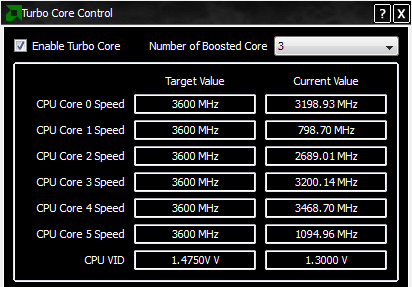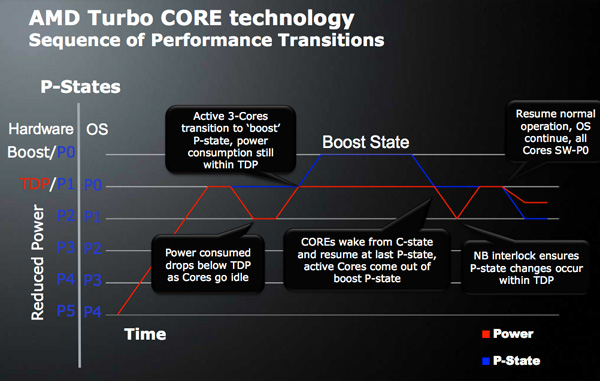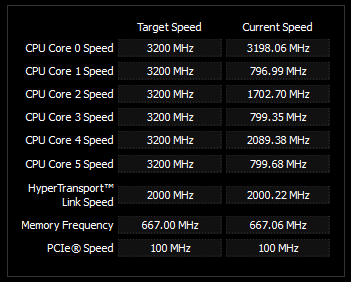AMD's Six-Core Phenom II X6 1090T & 1055T Reviewed
by Anand Lal Shimpi on April 27, 2010 12:26 AM EST- Posted in
- CPUs
- AMD
- Phenom II X6
AMD’s Turbo: It Works
In the Pentium 4 days Intel quickly discovered that there was a ceiling in terms of how much heat you could realistically dissipate in a standard desktop PC without resorting to more exotic cooling methods. Prior to the Pentium 4, desktop PCs saw generally rising TDPs for both CPUs and GPUs with little regard to maximum power consumption. It wasn’t until we started hitting physical limits of power consumption and heat dissipation that Intel (and AMD) imposed some limits.
High end desktop CPUs now spend their days bumping up against 125 - 140W limits. While mainstream CPUs are down at 65W. Mobile CPUs are generally below 35W. These TDP limits become a problem as you scale up clock speed or core count.
In homogenous multicore CPUs you’ve got a number of identical processor cores that together have to share the maximum TDP of the processor. If a single hypothetical 4GHz processor core hits 125W, then fitting two of them into the same TDP you have to run the cores at a lower clock speed. Say 3.6GHz. Want a quad-core version? Drop the clock speed again. Six cores? Now you’re probably down to 3.2GHz.
| Single Core | Dual Core | Quad Core | Hex Core |
 |
 |
 |
 |
 |
 |
 |
 |
This is fine if all of your applications are multithreaded and can use all available cores, but life is rarely so perfect. Instead you’ve got a mix of applications and workloads that’ll use anywhere from one to six cores. Browsing the web may only task one or two cores, gaming might use two or four and encoding a video can use all six. If you opt for a six core processor you get great encoding performance, but worse gaming and web browsing performance. Go for a dual core chip and you’ll run the simple things quickly, but suffer in encoding and gaming performance. There’s no winning.
With Nehalem, Intel introduced power gate transistors. Stick one of these in front of a supply voltage line to a core, turn it off and the entire core shuts off. In the past AMD and Intel only put gates in front of the clock signal going to a core (or blocks of a core), this would make sure the core remained inactive but it could still leak power - a problem that got worse with smaller transistor geometries. These power gate transistors however addressed both active and leakage power, an idle core could be almost completely shut off.
If you can take a single core out of the TDP equation, then with some extra logic (around 1M transistors on Nehalem) you can increase the frequency of the remaining cores until you run into TDP or other physical limitations. This is how Intel’s Turbo Boost technology works. Depending on how many cores are active and the amount of power they’re consuming a CPU with Intel’s Turbo Boost can run at up to some predefined frequency above its stock speed.

With Thuban, AMD introduces its own alternative called Turbo Core. The original Phenom processor had the ability to adjust the clock speed of each individual core. AMD disabled this functionality with the Phenom II to avoid some performance problems we ran into, but it’s back with Thuban.
If half (or more) of the CPU cores on a Thuban die are idle, Turbo Core does the following:
1) Decreases the clock speed of the idle cores down to as low as 800MHz.
2) Increases the voltage of all of the cores.
3) Increases the clock speed of the active cores up to 500MHz above their default clock speed.

The end result is the same as Intel’s Turbo Boost from a performance standpoint. Lightly threaded apps see a performance increase. Even heavily threaded workloads might have periods of time that are bound by the performance of a single thread - they benefit from AMD’s Turbo Core as well. In practice, Turbo Core appears to work. While I rarely saw the Phenom II X6 1090T hit 3.6GHz, I would see the occasional jump to 3.4GHz. As you can tell from the screenshot above, there's very little consistency between the cores and their operating frequencies - they all run as fast or as slow as they possibly can it seems.
| AMD's Turbo Core Benefit | |||||
| AMD Phenom II X6 1090T | Turbo Core Disabled | Turbo Core Enabled | Performance Increase | ||
| x264-HD 3.03 1st Pass | 71.4 fps | 74.5 fps | 4.3% | ||
| x264-HD 3.03 2nd Pass | 29.4 fps | 30.3 fps | 3.1% | ||
| Left 4 Dead | 117.3 fps | 127.2 fps | 8.4% | ||
| 7-zip Compression Test | 3069 KB/s | 3197 KB/s | 4.2% | ||
Turbo Core generally increased performance between 2 and 10% in our standard suite of tests. Given that the max clock speed increase on a Phenom II X6 1090T is 12.5%, that’s not a bad range of performance improvement. Intel’s CPUs stand to gain a bit more (and use less power) from turbo thanks to the fact that Lynnfield, Clarkdale, et al. will physically shut off idle cores rather than just underclock them.

I have noticed a few situations where performance in a benchmark was unexpectedly low with Turbo Core enabled. This could be an artifact of independent core clocking similar to what we saw in the Phenom days, however I saw no consistent issues in my time with the chip thus far.










168 Comments
View All Comments
Calin - Tuesday, April 27, 2010 - link
Unfortunately in my experience, antivirus seems hard-drive limited even on Conroe dual core processors.kmmatney - Tuesday, April 27, 2010 - link
I would agree. Going to an SSD will probably make more difference than adding more cores, when it comes to everyday multitasking.KaarlisK - Tuesday, April 27, 2010 - link
You're lucky, both MSE and AVG usually hit 100% of one core both for my 1.8 and 2.33 GHz Core 2 Duos.Taft12 - Tuesday, April 27, 2010 - link
Frankly, the list of apps you provide would run just fine on a single-core CPU.beginner99 - Tuesday, April 27, 2010 - link
yep, like on my netbook with a z520 atom. AVG + utorrent + FF or chrome no issue (unless of course hd flash movies but that's another story).On my desktop (which is also a pretty old and crappy e4300) i also have seti@home. so basically i'm always at 100% cpu but still feel the hdd is limiting.
Scali - Wednesday, April 28, 2010 - link
Yes it makes sense... things like browsers, IM, email don't take a lot of CPU. They can easily be juggled by the OS on just a single core (or with hardware, using HT).More processes don't necessarily require more cores.
I mean, I am currently running two instances of Visual Studio, a browser with 10 tabs open, Skype, Spark, Notepad++, Outlook and a few other small things in the tray or background, and my dualcore still is at 1% CPU usage, according to Task Manager, and that 1% CPU is Task Manager itself. So why would I want 4 cores, let alone 6?
It really doesn't matter.
eekamouse - Tuesday, April 27, 2010 - link
I think there is something really good that could be tested here, the performance of these chips running virtual machines especially with hypervisor technology..Any possibility of testing these chips running either xen or vmware and seeing how 4 virtual machines react on each and how 6 react ? is the performance stable etc ? The reason I ask this is for the price point if it can run 6 virtual machines all running off of their own core or sharing cores and can maintain a good performance, it would be really worthwhile investing in these for cheap virtualisation servers..
rickcain2320 - Tuesday, April 27, 2010 - link
That's all you need to know. Time to ditch my Q6600.fitten - Tuesday, April 27, 2010 - link
Well... we haven't seen the consumer priced hex-core Intel parts yet... Everybody is comparing this to the high-end Intel parts (i7-980X is a high-end part). I'll wait to see what Intel's response is before removing them from the table.formulav8 - Tuesday, April 27, 2010 - link
Enjoy! the waiting game... I still doubt Intel would lower prices near AMD's 6 core do to the fact that they will be ruining their much more profitable mainstream parts.Jason